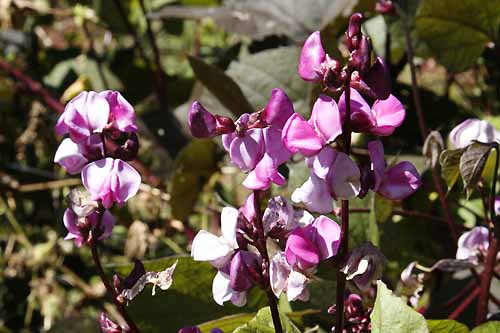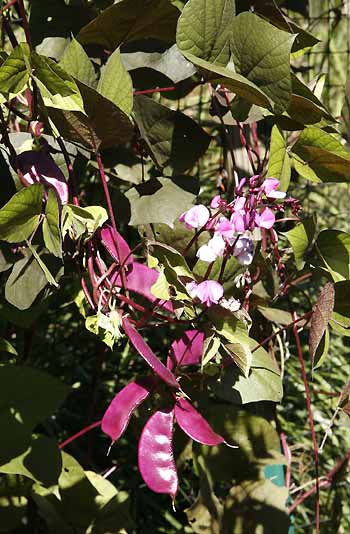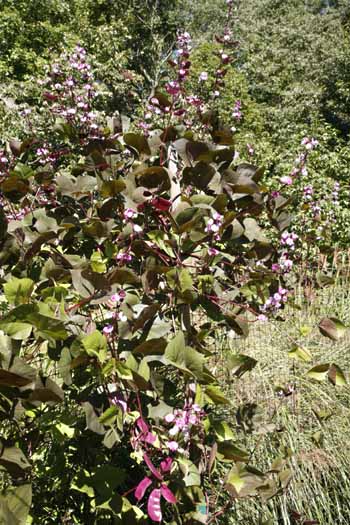Hyacinth beans are a wonderful bright addition to any garden. This vine is
grown mostly as an annual and needs a climbing surface in full sun. It's not
fussy about soil type but prefers some organic material and some watering for
best flower production. It's fairly drought tolerant once established and needs
little maintenance once it's growing. It will flower from mid summer until the
frost and after the flowers the bright purple pods are just as attractive as
the flowers. If you want a fast growing annual fence or screen this is an ideal
plant.
We have not found that deer eat it but it's possible they just have not found
it yet since we grow it up our deer fencing.
Description of Hyacinth Bean.
Hyacinth bean is an ornamental twining vine. In most cases it is grown as an
annual. It is listed as a tender perennial and will overwinter in zones 10 or
greater. It is a beautiful fast growing vine with lustrous purple tinged heart
shaped leaves on short stalks. It can reach 20 feet in height (or length) in
a single season. Once it reaches about 10 feet it begins to flower. It has long
spikes of fragrant pea-like bright pink or rose-purple colored blossoms that
are followed by flat glossy bright purple seed pods about 6 inches long and
1 ½" wide. These are produced in clusters. The plant will flower
until the first killing frost.
Location and care of Hyacinth bean
Plants do best in full sun. They are not really fussy about the kind of soil
and will grow in almost anything. However for best results and good flower production
a well drained soil with a reasonable amount of organic material is best. It
also prefers soil within a reasonable pH range, anything too acid or alkaline
will reduce its production. However, if organic material is added to the soil
it should bring the pH into a tolerable range. This produces the strongest plants
and the most flowers.
The plant is fairly drought tolerant once established but if good flower production
is desired a twice weekly watering is recommended. A soaker hose along the base
of the plants is the ideal way to water them; give them some water each day.
Once established the plants do not need any fertilization. Nitrogen fertilizer
will inhibit flowering and produce more glossy leaves. The plant is in the legume
family and fixes its own nitrogen which can benefit other plants in the area.
Apart from watering the plant really needs no other maintenance. Remove weeds
from around the vine base, taking care not to pull out the vine at the same
time. (it can be easy to do). Otherwise that's it. Water and enjoy.
This plant is most commonly grown up a fence or trellis however it can be grown
across the ground and makes an excellent annual ground cover.
Trellis growing. Plants need a sturdy trellis of some kind. This can be as simple
as a piece of bird netting tacked to the side of a house or a strong metal trellis.
Don't use one with too large a mesh size or the beans will have trouble growing
up as they can't find enough hold. Vines are very tough and removing them at
the end of the season or even the following spring can be a difficult job. This
is something you may wish to consider before choosing your trellis material.
Ground Cover. Ensure that the soil has some organic material and is fairly weed free before planting. Plant beans in rows about three feet apart; water until the beans germinate. In most cases the beans will grow and smother most of the germinating weeds. However they will not compete with strong growing tall weeds which will need to be removed as they arise. Ground grown beans are used as forage for animals as well as a lovely flowering carpet.
Growing Hyacinth Bean from Seed.
Although this plant can be started indoors its is usually not worth the trouble.
In many cases planting out stunts the plants and slows down vine growth. Plants
can grow extremely fast when in pots and often create long vines before they
can be planted outside. Thus when they are planted out they are set back and
often sunburnt.
We have tried both and found that direct sowing is the most effective way to
grow this lovely plant.
Sow seeds directly in the ground where they are to grow after all danger of
frost has passed and the soil temperatures have reached the mid 60's Fahrenheit
( ~ 18 C). Ensure that there is some organic material in the soil and water
well until germination. This can take as little as a few days to a couple of
weeks depending on temperature. Plant seeds about 3 inches apart for the best
display. If planting as a ground cover space rows about three feet apart.
Problems of Hyacinth Bean
No serious insect or disease problems though it is much beloved by Japanese
beetles, which can make the leaves resemble Swiss cheese. Vines survive, however,
and produce handsome new foliage for late season enjoyment.
Edible Uses of Hyacinth Bean.
The young pods are listed as edible and can be used like French beans. When
cooked they lose their purple color and turn green. (personally we have tried
these beans and don't like the taste, but maybe others will). If using the pods
make sure that they are young with immature seeds since the mature dry seeds
are poisonous.
The leaves and flowers are also edible and can be used in a variety of dishes.
Leaves should be cooked and not eaten raw. Flowers can be eaten raw if desired.
The roots can also be used; they are large and starchy.
Caution. The mature seeds are poisonous unless boiled with several changes of
water to remove the toxic content. Once prepared they can be used to make tofu
and fermented into 'tempeh'.
Medicinal Uses of Hyacinth Bean
The plant is used as an antidote to many forms of poison and prolongs coagulation
time. It is used to treat leucorrhoea, gonorrhea, alcoholic intoxication and
globefish poisoning. The stems are used to treat cholera and the juice from
the pods to treat inflamed ears and throats. The fully mature seeds are dried
and roasted before use for many different medicinal purposes including stomach
disorders, nausea, vomiting, diarrhea, enteritis, abdominal pain, alcoholism
and arsenic poisoning.
Plants are fairly fast growing and the bacteria on the roots enrich the soil with nitrogen. This makes them a good green manure crop in warm climates.
Other names
lablab vulgaris. Dolichos lablab. Dolichos niger, Dolichos purpureu, Lablab violet, Lablab violet bean, Purple Lablab, Lablab bean, Indian Bean, calavance, seim, Egyptian Bean, njahi, bulay, bataw.
Misspellings: Lablan bean, Lablan violet, Lablan violet bean, Lablan, Purple lablan, purple lablan bean,
.








